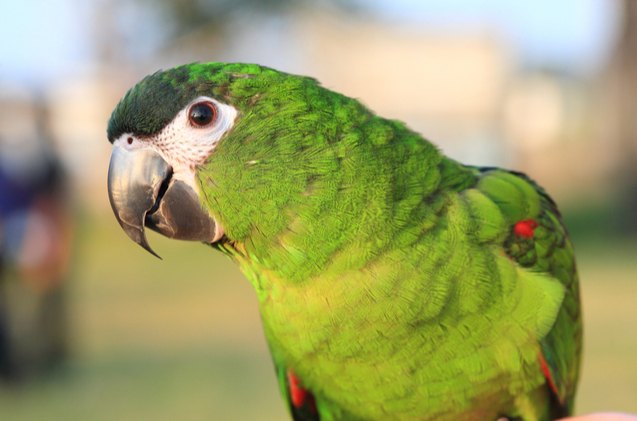Hahn’s Macaw


About Hahn’s Macaw
We all know about the big macaw breeds as they’re the most famous, but what about the tiny ones? Meet the Hahn’s Macaw. These adorable birds are the smallest, most talkative of all macaw parrots, and are cute and goofy pet birds. They are also very easy to care for, and with their friendly nature full of goofs and mimics, they are a fantastic choice for a beginner pet parrot.
Small, cute and goofy, these natural talkers are a bundle of fun and are easy to look after.
Native Region/Natural Habitat
The Hahn’s Macaw belongs to the small group of Red Shouldered macaws that are native to the South American continent, in a region of tropical woodlands, savannahs and swamps that spans Venezuela, Guyana, Suriname, Brazil, and Peru. They choose sparse woodland and brushland to nest, often in palm groves, preferring to breed in tree holes and dead palms.
Their small size earned them the popular nickname of “mini macaws,” as the adults will reach an average size of 12 inches (30 centimeters) in length. Just like their big cousins, they have the distinctive narrow tails and big and powerful head and beak. Males and females are exactly the same so there’s no easy way to differentiate them. Their lifespan reaches up to 30 years and more, less than the bigger macaws, but still enough to become a lifelong friend.
These cute birds have a reputation for being one of the best talkers in the world of avians. Hahn’s Macaw is smart and eager to learn and mimic new words, which they will repeat in a clear, cartoonish voice, ensuring a silly and comical show for their owner. It shouldn’t be surprising for your pet to develop a vocabulary of up to 20 or more words. They also have a loud screeching call, but luckily it is not often that they use it. They can be noisy only when they are bored, angry or threatened.
These macaws are almost entirely green. Besides this tropical color, they have a few distinguishing traits, like the dark colored forehead, the bluish plumage under the wings, as well as the red spotted “shoulders,” giving them their alternative name. They are different from other mini-macaws, and one particular unique trait is the prominent black beak. These colors give them a strong tropical vibe, and an interesting look.
Small red spots on their wings have earned them a popular nickname – The Red Shouldered Macaw.
Various seeds, fruits, nuts and tree blossoms are the foundation of a Hahn’s macaw diet in the wild. For your pet, this diet can be achieved in captivity with the common macaw seed or pellet mix that can be found in pet stores. But you’d also want to balance it out with regular addition of fresh fruits, berries, and green vegetables. A cuttlebone can serve as good source of calcium and vitamin, as well as a chance for them to work their powerful beaks.
Like their larger cousins, these so-called “dwarf macaws” are likewise very hardy and enduring birds. Following the regular routines of proper care will help your macaw reach old age. These include great hygiene, a balanced diet and a lot of opportunity for exercise. Remember that a bored, neglected or constantly locked bird is prone to illness.
These birds are playful and full of energy. Provide ample room and plenty of toys. They are real munchers and like to chew on anything they can, so toys are a good investment.
Full of energy and desire to play, the Hahn’s Macaw needs your company and care.
A Red Shouldered macaw is a lovable pet with a mellow temperament. It has a lot of the desirable pet bird traits and a kind, silly personality which you will grow to love. Cuddles, head scratches and handling, in general, are a favorite of theirs, and they won’t hesitate to follow you around and use every chance to play. All of their good traits, and the fact they are hardy and easy to look after, make them a perfect pet parrot for beginners and seniors, but also a fantastic family pet.
Photo credit: Bplanet/Shutterstock; OnizukaGTO/Shutterstock

A proud mama to seven dogs and ten cats, Angela spends her days writing for her fellow pet parents and pampering her furballs, all of whom are rescues. When she's not gushing over her adorable cats or playing with her dogs, she can be found curled up with a good fantasy book.
More by Angela Vuckovic

























